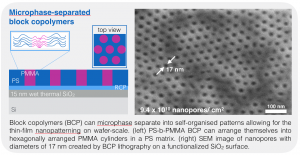Block copolymer lithography is an emerging self-assembly technique for the large-area patterning of surfaces with regular nanosized features.
 We investigate the microphase separation behavior of Poly(styrene-b-methylmethacrylate) (PS-b-PMMA) block copolymers to create nanopores in a PS matrix in thin films. During the annealing of PS-b-PMMA thin films on solid surfaces polymers form ordered homopolmyer domains, i. e. nanoscopic PS- and PMMA-rich areas. Patterns like stripes, cylinders-in-matrix or spheres-in-matrix with feature sizes of few nm can be produced by choosing appropriate polymer block-length ratios and molecular weights. Adjusting annealing temperatures and times as well as polymer film thicknesses, the pattern homogeneity can be optimized.
We investigate the microphase separation behavior of Poly(styrene-b-methylmethacrylate) (PS-b-PMMA) block copolymers to create nanopores in a PS matrix in thin films. During the annealing of PS-b-PMMA thin films on solid surfaces polymers form ordered homopolmyer domains, i. e. nanoscopic PS- and PMMA-rich areas. Patterns like stripes, cylinders-in-matrix or spheres-in-matrix with feature sizes of few nm can be produced by choosing appropriate polymer block-length ratios and molecular weights. Adjusting annealing temperatures and times as well as polymer film thicknesses, the pattern homogeneity can be optimized.
We create nanopores with diameters of 17 nm in PS thin films on several materials surfaces at pore densities of up to 9.4 x 1010 cm-2, as shown in the SEM image.
We investigate the influence of the surface free energy between substrate surface and the block copolymers on the phase separation behavior into ordered patterns as well as the polymers behavior on prepatterned surfaces.